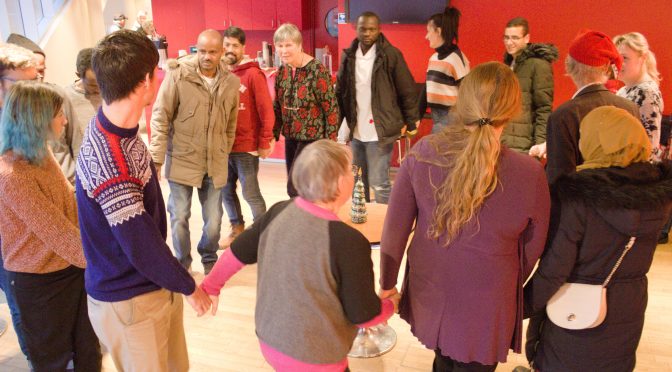PLASSEN (Panorama): Yesterday, learners of Norwegian language gathered for the last time in 2019 at the language café to immerse themselves in the atmosphere of Norwegian Christmas.
By UMID MIRZAEV (text & photo)
Christmas is a celebration shared all over the world, in countries with a wide variety of cultures, history, and climate. How do people celebrate Christmas? By tradition – of course, at home, because this is a family holiday. The traditions in many countries coincide, but each country has its habits, especially for the Christmas table.

The visitors got the opportunity to familiarize themselves and discuss Christmas in a Norwegian manner. The meeting began with the discussion of traditional Christmas food in Norway. Although meals may vary widely from south to north throughout the country, the Christmas dinner in Norway has some common features. The most popular Christmas dishes – “ribbe” (pork rib) and “pinnekjøtt” (lamb or mutton rib). Since Norway has long been famous for its fishing traditions, it is not surprising that fish dishes are also served on Christmas Eve: “lutefisk” (made from stockfish treated with lye) or “rakfisk” (made from trout and salted and fermented for 2-3 months).

During the coffee break, participants had the chance to try Christmas baked cookies prepared by teachers: “pepperkaker” (gingerbread) and “serinakaker” (cookies with sugar and almonds). It should also be noted that each participant received a small Norwegian Christmas present – a figurine of “nisse” (Norwegian Santa-gnome).

After the food discussion, the teachers encouraged participants to learn and sing together popular Norwegian Christmas songs: “På låven sitter nissen” (On the barn sits the gnome) and “Så går vi rundt om en enebærbusk” (Then we walk around a juniper bush). In the end the students formed the circle, held hands and started walking around the toy Christmas tree, smiling and singing these Christmas songs.
“Today’s meeting was very nice and made me feel happy and comfortable. We received gifts from the teachers and it means a lot to me. It was difficult for me to start learning Norwegian from scratch, but after joining språkkafé it became much easier, it motivates me to learn Norwegian. People here are very helpful, friendly and welcoming. I feel like I’m with my immediate family on Tuesdays during my Norwegian course” says Rabah Taif, an Algerian first-year master’s student in petroleum logistics.

We asked Øyvind Halskau, one of the volunteer teachers at the café – and professor emeritus of logistics at HiMolde – about his experience of teaching Norwegian and Christmas celebration in Norway.
– Øyvind, how long have you been teaching Norwegian and why you decided to teach it?
– I have been teaching Norwegian at språkkafé for two years. I think it is fun to teach Norwegian, because it is always very strange to try to teach foreigners your own language. You can discover things about your own language. To explain different expressions that is evident for me, but it is hard to explain them for foreigners. So that is very interesting.
– Can you share some tips for our international students regarding learning the language?
– Haha … (smiles). Like any foreign language, you have to try and accept that you make mistakes. Sometimes, we, Norwegians, laugh on your mistakes. But when I speak English, I am quite sure that polite Englishmen will not laugh at me, but he will understand even if I make big serious mistakes. The only way to learn the language is to use the language, to make mistakes and try, try, try.
– What are the main features of Norwegian Christmas celebration?
– Uff … It is a very difficult question. I think it has been changed, but slowly. Very many youngsters are becoming vegetarians, since it is a kind of new religion: to believe in not eating meat. That has affected Christmas celebration. But I think giving presents, having family parties will still be very important for many-many years in Norway.
God jul! Merry Christmas!

